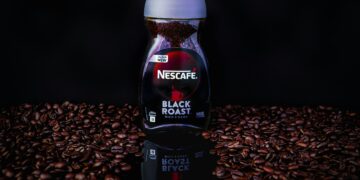Table of Contents
For years, I was a true believer in the promise of French press cold brew.
As a coffee obsessive who has spent the better part of a decade chasing the perfect cup, the idea was intoxicatingly simple.
Use the most elegant and straightforward brewer in my arsenal to create the smoothest, richest, lowest-acid coffee imaginable.
The internet was filled with guides and videos, each promising a foolproof path to cold brew bliss in just a few easy steps.1
My reality, however, was a gritty, bitter mess.
Every attempt was a new kind of failure.
One batch would be punishingly bitter, an over-extracted nightmare that tasted like stale, burnt ash.
The next would be shockingly weak and watery, with a thin, sour character that was even more disappointing.
But the one constant, the unforgivable sin that ruined every single glass, was the sludge.
No matter how carefully I followed the instructions, the bottom of my cup was always coated in a fine, gritty layer of sediment that destroyed the luxurious texture cold brew is famous for.4
My rock bottom came on a sunny Saturday morning.
I had invited friends over for brunch, confidently boasting that I was preparing a large, beautiful carafe of homemade cold brew.
I had followed a popular recipe to the letter.
The result? A murky, muddy brew so full of grit that it was undrinkable.
I remember the quiet humiliation of pouring the entire batch down the drain, the sludgy grounds clinging to my sink as I sheepishly fired up my old drip machine in defeat.
That failure was my catalyst.
I put the French press away and vowed to understand why this seemingly simple method was so prone to disaster.
Part 1: The Three Sins of French Press Cold Brew: Why Most Recipes Fail You
My journey began by deconstructing the problem.
I realized that the very design that makes a French press a champion of hot, full-bodied coffee—its simple metal mesh filter—is its Achilles’ heel for the long, slow process of cold brewing.
Most online recipes fail because they don’t address the three fundamental flaws this creates.
The Sin of Sediment – The Gritty Mouthfeel
The gritty texture that plagued my coffee comes from one primary source: “fines”.4
These are microscopic coffee particles that are smaller than the holes in the press’s metal filter.
They are an unavoidable byproduct of grinding, but their quantity explodes when using an inconsistent blade grinder, which smashes beans into a chaotic mix of boulders and dust.4
The common advice to “plunge slowly” is a well-intentioned but ultimately inadequate solution.
While a fast, aggressive plunge will certainly make things worse by acting like a hydraulic press and forcing fines through the filter, a slow plunge can’t fix a brew that is already saturated with suspended particles.6
This revealed a critical connection I had been missing.
The sediment wasn’t just a textural problem; it was directly linked to the taste.
The same fines that slip through the filter to create sludge are also the first to ruin the flavor.
Because of their incredibly high surface area, these tiny particles extract far more rapidly than the larger, coarser grounds during the long 12 to 24-hour steep.
They quickly move past the sweet spot and begin leaching bitter-tasting compounds into the water, creating a vicious cycle where the cause of the bad texture is also the cause of the bad taste.8
Solving the sludge problem meant I had to solve the fines problem.
The Sin of Bitterness – The Over-Extracted Nightmare
Coffee extraction is a timed release of chemical compounds.
When water meets coffee, it first dissolves acids (which provide brightness), then sugars and oils (which give sweetness and body), and finally, bitter-tasting organic compounds.8
Hot water does this in minutes.
Cold brew, with its long, leisurely steep, makes it incredibly easy to cross the line from sweet to bitter, a state known as over-extraction.11
As I discovered, the primary driver of this bitterness was the over-extraction of fines.
But other factors contribute.
Steeping for far too long—some misguided recipes suggest 36 hours or more—is a guaranteed path to bitterness.
Using very dark, oily roasts can also be problematic, as their compounds are more soluble and prone to releasing harsh flavors.13
The Sin of Weakness – The Sour, Watery Disappointment
The opposite of a bitter brew is a weak and watery one, a sign of under-extraction.
This happens when the brewing process is cut short, extracting only the initial, tangy acids without giving the water enough time to access the deeper sweetness and rich body.8
The result is a hollow, disappointingly sour cup.
The culprits here are the inverse of those for bitterness: steeping for too short a time, using a grind that is too coarse for water to properly penetrate, or using a coffee-to-water ratio that is too diluted to begin with.6
Temperature also plays a key role that many guides gloss over.
Brewing in the cold environment of a refrigerator significantly slows down extraction, meaning a 12-hour steep that works at room temperature will produce a weak, sour brew if done in the fridge without extending the time.15
This led me to the second great contradiction in conventional wisdom.
The universal advice to “use a coarse grind” is dangerously incomplete.
What is truly needed is a uniformly coarse grind.
A cheap blade grinder produces an inconsistent mix of large chunks and fine dust.
This leads to a baffling brew that is simultaneously under-extracted from the large “boulders” and over-extracted from the fine “dust,” resulting in a coffee that is both sour and bitter.
The only way to achieve the necessary consistency is with a quality burr grinder, which mills the beans to a uniform size.6
This isn’t a pro-tip; it is the foundational requirement for success.
Part 2: The Epiphany: Your French Press Isn’t a Bucket, It’s an Infusion Pump
After my brunch disaster, I was truly ready to give up.
My French press sat in the back of a cabinet, a monument to my failure.
The breakthrough came from a place I never expected: an article about medical technology.
I was reading about transdermal patches and intravenous infusion pumps, devices designed for a very specific purpose: to deliver a substance into a system slowly, steadily, and with minimal trauma or disruption.18
Suddenly, everything clicked into place.
I had been treating my French press like a bucket.
I’d dump in coffee and water, let it soak, and then use the plunger as a brute-force tool to squeeze the liquid O.T. This new analogy completely reframed the process.
The French press is not a bucket; it is a self-contained infusion system.
- The goal is not to soak, but to infuse. The process is about allowing water to gently and patiently extract the desirable soluble compounds—the sugars, oils, and delicate flavors—over a long period of time, just like a slow-drip IV.10
- The “plunge” is not a press. It is the final, delicate stage of separation. The goal is to use gravity and patience to leave the undesirable elements—the heavy grounds and the fine, bitter sludge—undisturbed at the bottom.
This mental shift from “soaking and pressing” to “infusing and separating” was the key.
It gave me a guiding principle that informed every subsequent step and led me to a method that finally worked.
Part 3: The Controlled Infusion Method: A Step-by-Step Guide to Flawless French Press Cold Brew
Armed with my new “Controlled Infusion” model, I developed a new method from the ground up.
Each step is designed to maximize gentle extraction while minimizing the agitation that creates sediment and bitterness.
Step 1: The Foundation – Calibrating Your Inputs
The quality of your final brew is dictated by the quality of your ingredients.
- Bean Selection: Start with a medium roast. These beans offer the best balance of developed sugars and body for cold brewing. Light roasts can sometimes taste thin or overly acidic when brewed cold, while dark roasts can quickly become bitter.8
- The Burr Grinder (Non-Negotiable): To repeat: this is the single most important tool for success. A quality burr grinder creates the uniform, coarse particles (the size of coarse sea salt or polenta) necessary for a clean, even infusion without excess fines.4
- Water Quality: Coffee is over 98% water. If your tap water has a noticeable taste, your coffee will too. Use filtered water to remove chlorine and other off-flavors, which allows the coffee’s true character to emerge.16
Step 2: The Infusion Ratio – Dialing in Your Concentrate
For maximum versatility, you’ll be making a concentrate that you can dilute later.
- The Ratio: A coffee-to-water ratio between 1:6 and 1:8 by weight is an excellent starting point for a strong but balanced concentrate.23
- Use a Scale: Ditch the measuring cups. Volume is inaccurate. A digital kitchen scale ensures precision and repeatability, which are cornerstones of the controlled infusion method.6
- My Recommended Start: For a standard 1-liter (34-ounce) French press, use 75 grams of coarsely ground coffee and 600 grams of filtered water. This creates a perfect 1:8 ratio.
Step 3: The Saturation – A Gentle Start
The goal is to wet all the grounds without stirring up a muddy storm.
- The Method: Add your 75g of ground coffee to the empty press. Pour about half of your water (300g) over the grounds. Wait 30 seconds. You will see a “crust” of grounds form on top. With a wooden or plastic spoon, gently press down on this crust to ensure all the coffee is saturated. Avoid aggressive stirring.3 Once the grounds are wet, add the remaining 300g of water.
Step 4: The Steep – Patience is a Virtue
Now, the slow infusion begins.
- Cover and Wait: Place the lid on the press with the plunger pulled all the way up. This keeps dust out while allowing the coffee to steep.
- Choose Your Location: Steeping at room temperature for 12 to 18 hours will yield a slightly richer, more full-bodied brew. Steeping in the refrigerator for 18 to 24 hours will slow the extraction, resulting in an exceptionally smooth and clean-tasting coffee.16 For your first time, I recommend a
16-hour steep at room temperature.
Step 5: The Separation – The “No-Plunge” Plunge
This is the most critical stage and where this method diverges from almost every other guide.
- After the 16-hour steep, gently break the crust on top with a spoon. You’ll see most of the grounds sink to the bottom.
- Using two spoons, skim off any remaining foam or floating particles from the surface.4
- Now, do nothing. Wait for at least 5 to 10 minutes. This is the magic step. During this wait, gravity does the hard work, pulling almost all of the suspended fines down to the bottom to form a stable, compact bed of sludge.
- After the wait, take the plunger and press it down only until it sits just below the surface of the liquid. Do not press it down to the grounds. You are not compressing anything. You are simply using the filter as a final strainer for the pour.27 This technique effectively turns your press into a decanter, allowing you to pour the clean coffee off the top of the settled sediment.
Step 6: The Decant and Double-Filtration
Now it’s time to collect your pristine concentrate.
- The Pour: Tip the press and pour the coffee slowly and steadily into a separate carafe or jar for storage. Stop pouring when you get to the last inch or so of liquid at the bottom. Don’t be greedy; this last bit is where the highest concentration of sludge lives. Sacrificing it is the key to a perfectly clean cup.17
- The Pro Step (Optional but Recommended): For absolute clarity, perform a second filtration. Pour your decanted concentrate through a paper coffee filter (like a V60), a fine-mesh kitchen sieve, or a few layers of cheesecloth.28 This will catch any remaining micro-fines and elevate your brew from great to flawless.
Part 4: The Advanced Practitioner’s Toolkit: Troubleshooting and Fine-Tuning
Once you’ve mastered the basic method, you can use the principles of controlled infusion to tweak the brew to your exact preferences.
This table is your control panel for creating a truly personalized cup.
Table 1: The Cold Brew Control Panel: Adjusting Variables for Your Perfect Cup
| Variable | Impact on Flavor (If Increased) | How to Adjust for… |
| Grind Size | Coarser = Slower extraction (less bitterness, less body). Finer = Faster extraction (more bitterness, more body, more sediment). | Weak/Sour Coffee: Grind slightly finer. Bitter/Muddy Coffee: Grind coarser. |
| Steep Time | Longer = More extraction (richer, but potentially more bitter). Shorter = Less extraction (brighter, but potentially weaker/sour). | Weak/Sour Coffee: Increase steep time (e.g., from 16 to 20 hours). Bitter Coffee: Decrease steep time (e.g., from 16 to 12 hours). |
| Coffee:Water Ratio | More Coffee = Stronger concentrate. Less Coffee = Weaker concentrate. | Weak Coffee: Increase coffee dose (e.g., from 1:8 to 1:6). Too Strong: Decrease coffee dose or dilute more when serving. |
| Water Temperature | Room Temp = Faster extraction, fuller body. Refrigerator = Slower extraction, cleaner/smoother profile. | For a richer brew: Steep at room temp. For an ultra-smooth brew: Steep in the fridge (and add 4-6 hours to the steep time). |
Common Questions Answered:
- How do I serve it? This method produces a concentrate. Start by diluting it with a 1:1 ratio of concentrate to cold filtered water or milk, then adjust to your taste.24 Remember that granulated sugar won’t dissolve well; use a simple syrup or liquid sweetener if desired.23
- How long does it last? Stored in a sealed, airtight container in the refrigerator, your concentrate will stay fresh and delicious for up to two weeks.25
- Is this better than a dedicated cold brewer? Brewers like the Toddy system are fantastic for making large, clean batches with minimal fuss, but they are a single-purpose tool. The beauty of the French press is its versatility. By mastering this infusion technique, you can achieve results that are just as clean and delicious without needing to buy more equipment.32
Conclusion: Your New Ritual for Perfect Cold Brew
I think back to that brunch disaster, to the frustration of pouring murky, bitter coffee down the drain.
It feels like a lifetime ago.
The French press that once sat in disgrace is now one of my most trusted tools.
The key was never about finding a magic recipe; it was about changing my entire understanding of the process.
The French press is not the problem; the conventional method Is. By abandoning the idea of brute-force pressing and embracing a new model of gentle, controlled infusion and separation, the path to a perfect cup becomes clear.
This method isn’t just a series of steps; it’s a ritual that respects the ingredients and the tool.
It’s the key to unlocking the full potential of your French press and finally enjoying the smooth, rich, and beautifully clear cold brew you were promised all along.
Works cited
- How to make cold brew with a coffee press #Starbucks #Shorts – YouTube, accessed August 6, 2025, https://www.youtube.com/shorts/fCIGR5QhQOU
- Cold Brew in a French Press Brewing Guide – Stone Street Coffee, accessed August 6, 2025, https://stonestreetcoffee.com/pages/cold-brew-in-a-french-press-brewing-guide
- How to Brew Cold Brew with a Coffee Press | Starbucks, accessed August 6, 2025, https://athome.starbucks.com/brewing-guide/how-brew-cold-brew-coffee-press
- 5 Ways To Reduce Sediment In Your French Press Coffee – JavaPresse, accessed August 6, 2025, https://www.javapresse.com/blogs/french-press/reduce-sediment-french-press-coffee
- Are we expected to get sediment in our coffee from French Press? – Reddit, accessed August 6, 2025, https://www.reddit.com/r/Coffee/comments/l5hhp8/are_we_expected_to_get_sediment_in_our_coffee/
- Common French Press Mistakes & How to Fix Them – Something’s Brewing, accessed August 6, 2025, https://somethingsbrewing.in/blogs/brewing-tips/common-french-press-mistakes-how-to-fix-them
- The Best French Press Recipe – Perfect Coffee Every Time! – Feastography, accessed August 6, 2025, https://www.feastographyblog.com/recipes/french-press-recipe
- Having Trouble With Your Cold Brew Coffee? Here Are 5 Tricks To …, accessed August 6, 2025, https://www.javapresse.com/blogs/cold-brew/having-trouble-with-your-cold-brew-coffee-here-are-5-tricks-to-try
- Why is French Press Coffee Bitter? (Grind Size, Extraction, More), accessed August 6, 2025, https://easyhomecoffee.com/why-is-french-press-coffee-bitter/
- Cold Brew – the science, the art – Rare Breed Coffee, accessed August 6, 2025, https://rarebreedcoffee.com/blogs/coffee-origins/cold-brew-the-science-the-art
- How to Make Cold Brew Less Bitter: 8 Easy Fixes – Foragers of Happiness, accessed August 6, 2025, https://foragersofhappiness.com/how-to-make-cold-brew-less-bitter/
- Coffee Tastes Bitter? Here Why, And How To Fix It, accessed August 6, 2025, https://coffeebros.com/blogs/coffee/coffee-tastes-bitter-here-why-and-how-to-fix-it
- 5 Common French Press Mistakes You Must Avoid – BETTER BREW COFFEE, accessed August 6, 2025, https://www.betterbrew.coffee/french-press-articles/5-common-french-press-mistakes-you-must-avoid
- First attempt at cold brew very weak, what did I do wrong? : r/Coffee – Reddit, accessed August 6, 2025, https://www.reddit.com/r/Coffee/comments/4pa8dy/first_attempt_at_cold_brew_very_weak_what_did_i/
- What can I do to improve this cold-brew method? – Coffee Stack Exchange, accessed August 6, 2025, https://coffee.stackexchange.com/questions/3470/what-can-i-do-to-improve-this-cold-brew-method
- The Science of Cold Brew – Blue House Coffee, accessed August 6, 2025, https://bluehousecoffee.com/learn/the-science-of-cold-brew
- French Press Coffee Brewing – How to Reduce Sediment – Espresso Outlet LLC, accessed August 6, 2025, https://espressooutlet.com/blogs/news/french-press-coffee-brewing-how-to-reduce-sediment
- Chapter 1 Pharmacokinetics & Pharmacodynamics – Nursing Pharmacology – NCBI, accessed August 6, 2025, https://www.ncbi.nlm.nih.gov/books/NBK595006/
- Slow infusion tumescent anesthesia – PubMed, accessed August 6, 2025, https://pubmed.ncbi.nlm.nih.gov/9693671/
- Intravenous Fluid Regulation: Purpose, Procedure, and More – Healthline, accessed August 6, 2025, https://www.healthline.com/health/intravenous-fluid-regulation
- The science behind cold brew extraction: How does it really work? – Hardtank, accessed August 6, 2025, https://hardtank.com/2025/05/06/science-of-cold-brew-extraction/
- Troubleshooting French Press Coffee – INeedCoffee, accessed August 6, 2025, https://ineedcoffee.com/troubleshooting-french-press-coffee/
- Cold Brew with a French press? : r/Coffee – Reddit, accessed August 6, 2025, https://www.reddit.com/r/Coffee/comments/y1ocug/cold_brew_with_a_french_press/
- How to Make Cold Brew with a French Press | Easiest Method …, accessed August 6, 2025, https://kaldiscoffee.com/blogs/recipes/how-to-make-cold-brew-with-a-french-press
- How to Make French Press Cold Brew Concentrate – Fonté Coffee Roaster, accessed August 6, 2025, https://www.fontecoffee.com/blog/how-to-make-french-press-cold-brew-concentrate/
- Perfect Homemade Cold Brew French Press Coffee – The Practical Kitchen, accessed August 6, 2025, https://thepracticalkitchen.com/easy-french-press-cold-brew-coffee/
- The Ultimate French Press Technique – YouTube, accessed August 6, 2025, https://www.youtube.com/watch?v=st571DYYTR8
- French Press Cold Brew and related matters : r/Coffee – Reddit, accessed August 6, 2025, https://www.reddit.com/r/Coffee/comments/14yq1r9/french_press_cold_brew_and_related_matters/
- Filtering out cold brew sediment : r/Coffee – Reddit, accessed August 6, 2025, https://www.reddit.com/r/Coffee/comments/3kwrtf/filtering_out_cold_brew_sediment/
- What’s the best way to filter the grounds out of cold brew when you make it? I t… | Hacker News, accessed August 6, 2025, https://news.ycombinator.com/item?id=14507784
- How to Make Cold Brew French Press: Expert Guide for Best Results – Majesty Coffee, accessed August 6, 2025, https://majestycoffee.com/blogs/posts/how-to-make-cold-brew-french-press
- The Beginner’s Guide to Immersion Cold Brew Coffee – Handground, accessed August 6, 2025, https://handground.com/grind/beginners-guide-immersion-cold-brew-coffee
- Toddy vs French Press cold brew? : r/Coffee – Reddit, accessed August 6, 2025, https://www.reddit.com/r/Coffee/comments/9sevuf/toddy_vs_french_press_cold_brew/






